Komatsu PC800 -8, PC800LC -8 User Manual
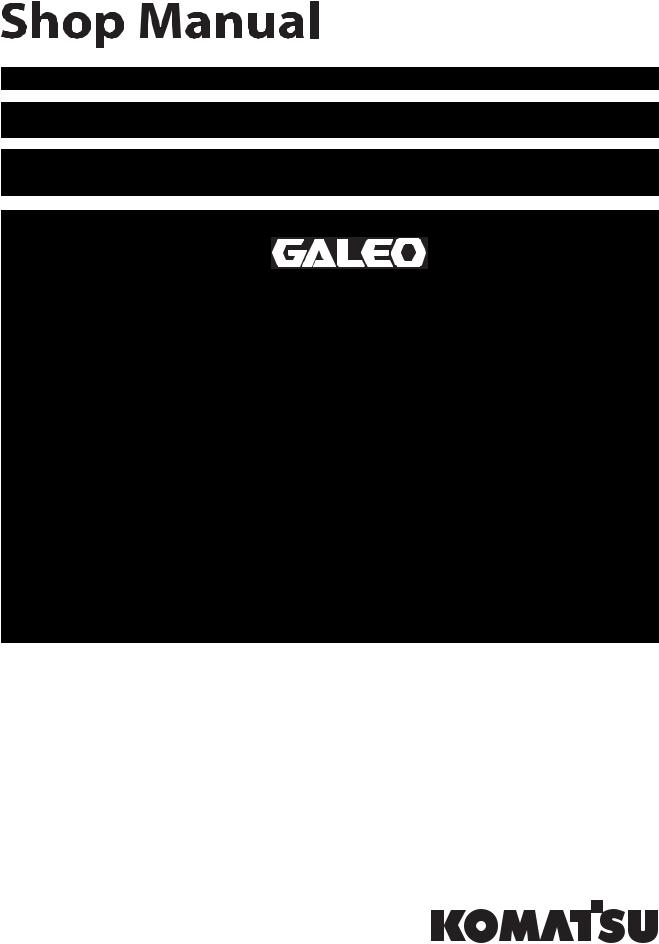
UEN00373-01
HYDRAULIC EXCAVATOR
PC800
PC800LC
-8 -8
SERIAL NUMBERS |
PC800- |
50001 |
and up |
PC800LC- |
50001 |
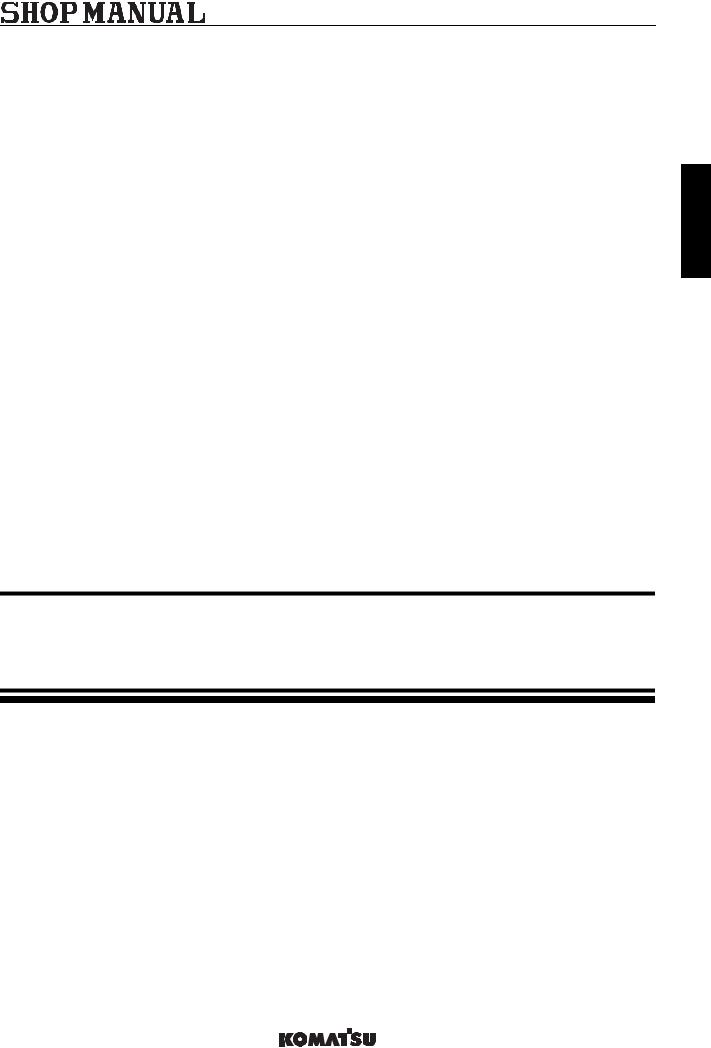
UEN00375-01
HYDRAULIC EXCAVATOR
PC800-8
PC800LC-8
Machine model |
Serial number |
PC800-8 |
50001 and up |
PC800LC-8 |
50001 and up |
00 Index and foreword
Index
Index
Organization list of the shop manual.................................................................................................... |
2 |
Table of contents .................................................................................................................................. |
4 |
PC800, 800LC-8 |
1 |
UEN00375-01 |
00 Index and foreword |
Organization list of the shop manual
The contents of this shop manual are shown together with Form No. in a list.
Note 1: Always keep the latest version of this manual in accordance with this list and utilize accordingly. The marks shown to the right of Form No. denote the following:
Q: New issue (to be filed additionally) q: Revision (to be replaced for each Form No.) Note 2: This shop manual can be supplied for each Form No.
Note 3: To file this shop manual in the special binder for management, handle it as follows:
•Place a divider on the top of each section in the file after matching the Tub No. with No. indicated next to each Section Name shown in the table below:
•File overview and other materials in sections in the order shown below and utilize them accordingly.
Section Title
Shop Manual, contents binder, binder label and tabs
00 Index and foreword Index
Foreword and general information
01Specification
Specification and technical data
10 Structure, function and maintenance standard Engine and cooling system
Power train Undercarriage and frame Hydraulic system, Part 1 Hydraulic system, Part 2 Work equipment
Cab and its attachments Electrical system
20 Standard value table Standard service value table
30 Testing and adjusting Testing and adjusting, Part 1 Testing and adjusting, Part 2 Testing and adjusting, Part 3 Testing and adjusting, Part 4 Testing and adjusting, Part 5
40Troubleshooting
General information on troubleshooting Troubleshooting by failure code (Display of code), Part 1 Troubleshooting by failure code (Display of code), Part 2 Troubleshooting by failure code (Display of code), Part 3 Troubleshooting of electrical system (E-mode)
Troubleshooting of hydraulic and mechanical system (H-mode) Troubleshooting of engine (S-mode)
Form Number
UEN00373-01
UEN00375-01 UEN00376-00
UEN00378-00
UEN00380-00 UEN00381-00 UEN00382-00 UEN00383-00 UEN00384-00 UEN00385-00 UEN00396-00 UEN00386-00
UEN00784-00 Q
UEN00786-00 Q UEN00788-00 Q UEN00912-00 Q UEN00913-00 Q UEN00914-00 Q
UEN00789-00 Q UEN00790-00 Q UEN00791-00 Q UEN00792-00 Q UEN00793-00 Q UEN00794-00 Q UEN00795-00 Q
2 |
PC800, 800LC-8 |
00 Index and foreword |
UEN00375-01 |
90 Diagrams and drawings |
|
Hydraulic diagrams and drawings |
UEN00392-00 |
Electrical diagrams and drawings |
UEN00393-00 |
PC800, 800LC-8 |
3 |

UEN00375-01 |
00 Index and foreword |
Table of contents |
|
00 Index and foreword |
|
Index |
UEN00375-01 |
Organization list of the shop manual ....................................................................................... |
2 |
Table of contents...................................................................................................................... |
4 |
Foreword and general information |
UEN00376-00 |
Foreword and general information .............................................................................................. |
2 |
Safety notice ............................................................................................................................ |
2 |
How to read the shop manual.................................................................................................. |
6 |
Explanation of terms for maintenance standard ...................................................................... |
8 |
Handling electric equipment and hydraulic component ........................................................... |
10 |
How to read electric wire code................................................................................................. |
18 |
Method of disassembling and connecting push-pull type coupler ........................................... |
21 |
Standard tightening torque table.............................................................................................. |
24 |
Conversion table...................................................................................................................... |
28 |
01 Specification |
|
Specification and technical data |
UEN00378-00 |
Specification and technical data .................................................................................................. |
2 |
Specification drawings ............................................................................................................. |
2 |
Working range drawing............................................................................................................ |
3 |
Specifications........................................................................................................................... |
4 |
Weight table............................................................................................................................. |
10 |
Table of fuel, coolant and lubricants ........................................................................................ |
13 |
10 Structure, function and maintenance standard |
|
Engine and cooling system |
UEN00380-00 |
Engine and cooling system ......................................................................................................... |
2 |
Coupling................................................................................................................................... |
2 |
Coupling lubrication system..................................................................................................... |
3 |
Power train |
UEN00381-00 |
Power train .................................................................................................................................. |
2 |
Power train............................................................................................................................... |
2 |
Swing machinery ..................................................................................................................... |
4 |
Swing circle.............................................................................................................................. |
6 |
Final drive ................................................................................................................................ |
8 |
Sprocket................................................................................................................................... |
10 |
Undercarriage and frame |
UEN00382-00 |
Undercarriage and frame ............................................................................................................ |
2 |
Track frame and recoil spring .................................................................................................. |
2 |
Idler.......................................................................................................................................... |
4 |
Carrier roller............................................................................................................................. |
6 |
Track roller ............................................................................................................................... |
8 |
Track shoe ............................................................................................................................... |
10 |
Double shoe............................................................................................................................. |
13 |
Hydraulic system, Part 1 |
UEN00383-00 |
Hydraulic system, Part 1 ............................................................................................................. |
2 |
Hydraulic tank, hydraulic filter.................................................................................................. |
4 |
Hydraulic pump........................................................................................................................ |
6 |
Operation of pump control mechanism.................................................................................... |
12 |
EPC valve ................................................................................................................................ |
14 |
Self pressure reducing valve ................................................................................................... |
17 |
Cooling fan pump..................................................................................................................... |
21 |
Cooling fan motor .................................................................................................................... |
30 |
4 |
PC800, 800LC-8 |

00 Index and foreword |
UEN00375-01 |
Hydraulic system, Part 2 |
UEN00384-00 |
Hydraulic system, Part 2 ............................................................................................................. |
3 |
Motor grease pump ................................................................................................................. |
3 |
Return oil filter ......................................................................................................................... |
4 |
Line oil filter ............................................................................................................................. |
5 |
Drain oil filter............................................................................................................................ |
6 |
L.H. 5-Spool control valve........................................................................................................ |
8 |
R.H. 4-Spool control valve ....................................................................................................... |
14 |
Straight-travel valve ................................................................................................................. |
21 |
Swing motor............................................................................................................................. |
24 |
Center swivel joint ................................................................................................................... |
29 |
Travel motor............................................................................................................................. |
30 |
PPC accumulator..................................................................................................................... |
40 |
Work equipment, swing PPC valve.......................................................................................... |
41 |
Travel PPC valve ..................................................................................................................... |
46 |
Solenoid valve ......................................................................................................................... |
50 |
Hydraulic cylinder .................................................................................................................... |
56 |
Work equipment |
UEN00385-00 |
Work equipment .......................................................................................................................... |
2 |
Work equipment....................................................................................................................... |
2 |
Dimensions of work equipment ............................................................................................... |
4 |
Cab and its attachments |
UEN00396-00 |
Cab and its attachments.............................................................................................................. |
2 |
Air conditioner piping ............................................................................................................... |
2 |
Electrical system |
UEN00386-00 |
Electrical system ......................................................................................................................... |
2 |
Engine control.......................................................................................................................... |
2 |
Electric control system............................................................................................................. |
11 |
Monitor system ........................................................................................................................ |
45 |
Sensors ................................................................................................................................... |
63 |
20 Standard value table |
|
Standard service value table |
UEN00784-00 |
Standard service value table for engine ...................................................................................... |
2 |
Standard service value table for chassis ..................................................................................... |
3 |
30 Testing and adjusting |
|
Testing and adjusting, Part 1 |
UEN00786-00 |
Testing and adjusting, Part 1....................................................................................................... |
2 |
Tools for testing, adjusting and troubleshooting ...................................................................... |
2 |
Measuring engine speed ......................................................................................................... |
4 |
Measuring intake air pressure (Boost pressure)...................................................................... |
5 |
Measuring exhaust gas temperature ....................................................................................... |
6 |
Measuring exhaust gas color................................................................................................... |
7 |
Adjusting valve clearance........................................................................................................ |
8 |
Measuring compression pressure ........................................................................................... |
9 |
Measuring blow-by pressure ................................................................................................... |
10 |
Measuring engine oil pressure ................................................................................................ |
11 |
Handling of fuel system equipment ......................................................................................... |
12 |
Remaining pressure relief from fuel system equipment........................................................... |
12 |
Measuring fuel pressure .......................................................................................................... |
13 |
Testing fuel return rate and leakage ........................................................................................ |
14 |
Bleeding air from fuel circuit .................................................................................................... |
16 |
Testing and adjusting alternator belt tension ........................................................................... |
17 |
Testing and adjusting air conditioner compressor belt............................................................. |
18 |
PC800, 800LC-8 |
5 |

UEN00375-01 |
00 Index and foreword |
Testing and adjusting, Part 2 |
UEN00788-00 |
Testing and adjusting, Part 2 ....................................................................................................... |
2 |
Inspection of swing circle bearing clearance ........................................................................... |
2 |
Testing and adjusting track shoe tension................................................................................. |
3 |
Testing and adjusting work equipment, swing, and travel circuit oil pressures........................ |
4 |
Testing and adjusting control circuit oil pressure (self pressure reducing valve) ..................... |
9 |
Testing and adjusting main pump control pressure ................................................................. |
10 |
Testing and adjusting, Part 3 |
UEN00912-00 |
Testing and adjusting, Part 3 ....................................................................................................... |
2 |
Measuring PPC valve output pressure .................................................................................... |
2 |
Measuring outlet pressures of solenoid valve, swing PPC shuttle valve, and swing priority selector valve 6 |
|
Adjusting work equipment, swing PPC valve........................................................................... |
10 |
Testing and adjusting travel deviation...................................................................................... |
11 |
Inspection of locations of hydraulic drift of work equipment .................................................... |
13 |
Measuring fan speed ............................................................................................................... |
14 |
Measuring fan circuit oil pressure ............................................................................................ |
14 |
Measuring fan pump EPC current ........................................................................................... |
15 |
Measuring fan pump EPC solenoid valve output pressure...................................................... |
15 |
Measuring oil leakage.............................................................................................................. |
16 |
Release of residual pressure from hydraulic circuit ................................................................. |
20 |
Bleeding air from each part...................................................................................................... |
21 |
Inspection procedures for diode .............................................................................................. |
24 |
Testing and adjusting, Part 4 |
UEN00913-00 |
Testing and adjusting, Part 4 ....................................................................................................... |
2 |
Special function of machine monitor ........................................................................................ |
2 |
Handling engine controller high voltage circuit ........................................................................ |
33 |
Testing and adjusting, Part 5 |
UEN00914-00 |
Testing and adjusting, Part 5 ....................................................................................................... |
2 |
Procedure for turning on KOMTRAX terminal ......................................................................... |
2 |
KOMTRAX terminal lamp indications ...................................................................................... |
5 |
Preparation work for troubleshooting electrical system ........................................................... |
8 |
Pm-clinic service...................................................................................................................... |
11 |
40 Troubleshooting |
|
General information on troubleshooting |
UEN00789-00 |
General information on troubleshooting ...................................................................................... |
2 |
Points to remember when troubleshooting .............................................................................. |
2 |
Sequence of events in troubleshooting.................................................................................... |
3 |
Checks before troubleshooting ................................................................................................ |
4 |
Classification and troubleshooting steps ................................................................................. |
5 |
Connection table for connector pin numbers ........................................................................... |
9 |
T-boxes and T-adapters table .................................................................................................. |
32 |
Troubleshooting by failure code (Display of code), Part 1 |
UEN00790-00 |
Troubleshooting by failure code (Display of code), Part 1........................................................... |
3 |
Failure codes table .................................................................................................................. |
3 |
Information in troubleshooting table......................................................................................... |
8 |
Failure code [A000N1] Eng. Hi Out of Std ............................................................................... |
10 |
Failure code [AA10NX] Aircleaner Clogging............................................................................ |
12 |
Failure code [AB00KE] Charge Voltage Low ........................................................................... |
14 |
Failure code [B@BAZG] Eng. Oil Press. Low.......................................................................... |
16 |
Failure code [B@BAZK] Eng. Oil Level Low............................................................................ |
18 |
Failure code [B@BCNS] Eng. Water Overheat ....................................................................... |
20 |
Failure code [B@BCZK] Eng. Water Lvl Low .......................................................................... |
22 |
Failure code [B@HANS] Hydr. Oil Overheat ........................................................................... |
24 |
Failure code [CA111] ECM Critical Internal Failure.................................................................. |
26 |
Failure code [CA115] Eng Ne and Bkup Speed Sens Error..................................................... |
28 |
Failure code [CA122] Chg Air Press Sensor High Error .......................................................... |
30 |
6 |
PC800, 800LC-8 |

00 Index and foreword |
UEN00375-01 |
Failure code [CA123] Chg Air Press Sensor Low Error........................................................... |
33 |
Failure code [CA131] Throttle Sensor High Error.................................................................... |
34 |
Failure code [CA132] Throttle Sensor Low Error..................................................................... |
36 |
Failure code [CA135] Eng Oil Press Sensor High Error .......................................................... |
38 |
Failure code [CA141] Eng Oil Press Sensor Low Error........................................................... |
40 |
Failure code [CA144] Coolant Temp Sens High Error ............................................................. |
42 |
Failure code [CA145] Coolant Temp Sens Low Error.............................................................. |
44 |
Failure code [CA153] Chg Air Temp Sensor High Error .......................................................... |
46 |
Failure code [CA154] Chg Air Temp Sensor Low Error ........................................................... |
48 |
Failure code [CA187] Sens Supply 2 Volt Low Error ............................................................... |
49 |
Failure code [CA221] Ambient Press Sens High Error............................................................ |
50 |
Failure code [CA222] Ambient Press Sens Low Error............................................................. |
52 |
Failure code [CA227] Sens Supply 2 Volt High Error .............................................................. |
54 |
Failure code [CA234] Eng Overspeed..................................................................................... |
56 |
Failure code [CA238] Ne Speed Sens Supply Volt Error......................................................... |
58 |
Failure code [CA263] Fuel Temp Sensor High Error ............................................................... |
60 |
Failure code [CA265] Fuel Temp Sensor Low Error ................................................................ |
62 |
Failure code [CA271] IMV/PCV1 Short Error .......................................................................... |
63 |
Failure code [CA272] IMV/PCV1 Open Error .......................................................................... |
64 |
Failure code [CA273] PCV2 Short Error.................................................................................. |
65 |
Failure code [CA274] PCV2 Open Error.................................................................................. |
66 |
Failure code [CA322] Inj #1 (L#1) Open/Short Error ............................................................... |
67 |
Failure code [CA323] Inj #5 (L#5) Open/Short Error ............................................................... |
68 |
Failure code [CA324] Inj #3 (L#3) Open/Short Error ............................................................... |
69 |
Failure code [CA325] Inj #6 (L#6) Open/Short Error ............................................................... |
70 |
Failure code [CA331] Inj #2 (L#2) Open/Short Error ............................................................... |
71 |
Failure code [CA332] Inj #4 (L#4) Open/Short Error ............................................................... |
72 |
Failure code [CA351] Injectors Drive Circuit Error................................................................... |
74 |
Failure code [CA352] Sens Supply 1 Volt Low Error ............................................................... |
76 |
Failure code [CA386] Sens Supply 1 Volt High Error .............................................................. |
78 |
Troubleshooting by failure code (Display of code), Part 2 |
UEN00791-00 |
Troubleshooting by failure code (Display of code), Part 2........................................................... |
3 |
Failure code [CA441] Battery Voltage Low Error ..................................................................... |
3 |
Failure code [CA442] Battery Voltage High Error .................................................................... |
3 |
Failure code [CA449] Rail Press Very High Error.................................................................... |
4 |
Failure code [CA451] Rail Press Sensor High Error................................................................ |
6 |
Failure code [CA452] Rail Press Sensor Low Error ................................................................ |
8 |
Failure code [CA553] Rail Press High Error ............................................................................ |
8 |
Failure code [CA554] Rail Press Sensor In Range Error ........................................................ |
9 |
Failure code [CA559] Rail Press Low Error............................................................................. |
10 |
Failure code [CA689] Eng Ne Speed Sensor Error ................................................................. |
14 |
Failure code [CA731] Eng Bkup Speed Sens Phase Error...................................................... |
16 |
Failure code [CA757] All Persistent Data Lost Error................................................................ |
17 |
Failure code [CA778] Eng Bkup Speed Sensor Error.............................................................. |
18 |
Failure code [CA1228] EGR Valve Servo Error 1 .................................................................... |
20 |
Failure code [CA1625] EGR Valve Servo Error 2 .................................................................... |
21 |
Failure code [CA1626] BP Valve Sol Current High Error......................................................... |
22 |
Failure code [CA1627] BP Valve Sol Current Low Error.......................................................... |
24 |
Failure code [CA1628] Bypass Valve Servo Error 1 ................................................................ |
25 |
Failure code [CA1629] Bypass Valve Servo Error 2 ................................................................ |
26 |
Failure code [CA1631] BP Valve Pos Sens High Error............................................................ |
28 |
Failure code [CA1632] BP Valve Pos Sens Low Error ............................................................ |
30 |
Failure code [CA1633] KOMNET Datalink Timeout Error........................................................ |
31 |
Failure code [CA1642] EGR Inter Press Sens Low Error........................................................ |
33 |
Failure code [CA2185] Throt Sens Sup Volt High Error .......................................................... |
36 |
Failure code [CA2186] Throt Sens Sup Volt Low Error ........................................................... |
38 |
Failure code [CA2249] Rail Press Very Low Error................................................................... |
39 |
Failure code [CA2271] EGR Valve Pos Sens High Error......................................................... |
40 |
PC800, 800LC-8 |
7 |

UEN00375-01 |
00 Index and foreword |
Failure code [CA2272] EGR Valve Pos Sens Low Error.......................................................... |
42 |
Failure code [CA2351] EGR Valve Sol Current High Error...................................................... |
44 |
Failure code [CA2352] EGR Valve Sol Current Low Error....................................................... |
46 |
Failure code [CA2555] Grid Htr Relay Volt Low Error.............................................................. |
47 |
Failure code [CA2556] Grid Htr Relay Volt High Error............................................................. |
48 |
Failure code [D110KB] Battery Relay Drive S/C...................................................................... |
50 |
Failure code [D163KB] Flash Light Relay S/C......................................................................... |
52 |
Failure code [D195KB] Step Light Relay S/C .......................................................................... |
54 |
Failure code [DA25KP] Press. Sensor Power Abnormality ..................................................... |
56 |
Failure code [DA2SKQ] Model Selection Abnormality............................................................. |
58 |
Failure code [DA80MA] Auto. Lub. Abnormal.......................................................................... |
60 |
Failure code [DA2RMC] Pump Comm. Abnormality................................................................ |
62 |
Failure code [DAFRMC] Monitor Comm. Abnormality ............................................................. |
64 |
Failure code [DGE5KY] Ambi. Temp. Sensor S/C ................................................................... |
66 |
Failure code [DGH2KB] Hydr. Oil Temp. Sensor S/C .............................................................. |
68 |
Troubleshooting by failure code (Display of code), Part 3 |
UEN00792-00 |
Troubleshooting by failure code (Display of code), Part 3........................................................... |
4 |
Failure code [DH25KA] L Jet Sensor Disc............................................................................... |
4 |
Failure code [DH25KB] L Jet Sensor S/C................................................................................ |
6 |
Failure code [DH26KA] R Jet Sensor Disc. ............................................................................. |
8 |
Failure code [DH26KB] R Jet Sensor S/C ............................................................................... |
10 |
Failure code [DHPEKA] F Pump P. Sensor Disc. .................................................................... |
12 |
Failure code [DHPEKB] F Pump P. Sensor S/C ...................................................................... |
14 |
Failure code [DHPFKA] R Pump P. Sensor Disc. .................................................................... |
16 |
Failure code [DHPFKB] R Pump P. Sensor S/C ...................................................................... |
18 |
Failure code [DV20KB] Travel Alarm S/C ................................................................................ |
20 |
Failure code [DW41KA] Swing Priority Sol. Disc. .................................................................... |
22 |
Failure code [DW41KB] Swing Priority Sol. S/C ...................................................................... |
24 |
Failure code [DW43KA] Travel Speed Sol. Disc...................................................................... |
26 |
Failure code [DW43KB] Travel Speed Sol. S/C ....................................................................... |
28 |
Failure code [DW45KA] Swing Brake Sol. Disc....................................................................... |
30 |
Failure code [DW45KB] Swing Brake Sol. S/C........................................................................ |
32 |
Failure code [DW7BKA] Fan Reverse Sol. Disc. ..................................................................... |
34 |
Failure code [DW78KB] Fan Reverse Sol. S/C ....................................................................... |
36 |
Failure code [DWK0KA] 2-stage Relief Sol. Disc. ................................................................... |
38 |
Failure code [DWK0KB] 2-stage Relief Sol. S/C ..................................................................... |
40 |
Failure code [DX16KA] Fan Pump EPC Sol. Disc. .................................................................. |
42 |
Failure code [DX16KB] Fan Pump EPC Sol. S/C .................................................................... |
44 |
Failure code [DXAAKA] F Pump EPC Sol. Disc. ..................................................................... |
46 |
Failure code [DXAAKB] F Pump EPC Sol. S/C ....................................................................... |
48 |
Failure code [DXABKA] R Pump EPC Sol. Disc...................................................................... |
50 |
Failure code [DXABKB] R Pump EPC Sol. S/C....................................................................... |
52 |
Failure code [DY20KA] Wiper Working Abnormality................................................................ |
54 |
Failure code [DY20MA] Wiper Parking Abnormality ................................................................ |
56 |
Failure code [DY2CKB] Washer Drive S/C .............................................................................. |
60 |
Failure code [DY2DKB] Wiper Drive (For) S/C ........................................................................ |
62 |
Failure code [DY2EKB] Wiper Drive (Rev) S/C ....................................................................... |
66 |
Troubleshooting of electrical system (E-mode) |
UEN00793-00 |
Troubleshooting of electrical system (E-mode) ........................................................................... |
3 |
Before carrying out troubleshooting of electrical system ......................................................... |
3 |
Information contained in troubleshooting table ........................................................................ |
5 |
E-1 Engine does not start (Engine does not rotate)................................................................. |
6 |
E-2 Preheater does not operate .............................................................................................. |
9 |
E-3 Auto engine warm-up device does not work ..................................................................... |
14 |
E-4 Auto-decelerator does not operate.................................................................................... |
15 |
E-5 All work equipment, swing and travel do not move ........................................................... |
16 |
E-6 Machine push-up function does not operate normally ...................................................... |
18 |
E-7 Boom shockless function does not operate normally........................................................ |
20 |
8 |
PC800, 800LC-8 |

00 Index and foreword |
UEN00375-01 |
E-8 Any item is not displayed on machine monitor.................................................................. |
22 |
E-9 Part of display on machine monitor is missing.................................................................. |
23 |
E-10 Machine monitor displays contents irrelevant to the model ............................................ |
23 |
E-11 Fuel level monitor red lamp lights up while engine is running ......................................... |
24 |
E-12 Engine coolant thermometer does not display normally ................................................. |
26 |
E-13 Hydraulic oil temperature gauge does not display correctly............................................ |
28 |
E-14 Fuel gauge does not display correctly ............................................................................ |
29 |
E-15 Swing lock monitor does not display correctly ................................................................ |
30 |
E-16 When monitor switch is operated, nothing is displayed .................................................. |
32 |
E-17 Windshield wiper and window washer do not work......................................................... |
34 |
E-18 "Boom RAISE" is not correctly displayed in monitor function.......................................... |
42 |
E-19 "Boom LOWER" is not correctly displayed in monitor function ....................................... |
43 |
E-20 "Arm IN" is not correctly displayed in monitor function.................................................... |
44 |
E-21 "Arm OUT" is not correctly displayed in monitor function................................................ |
45 |
E-22 "Bucket CURL" is not correctly displayed in monitor function ......................................... |
46 |
E-23 "Bucket DUMP" is not correctly displayed in monitor function ........................................ |
47 |
E-24 "SWING" is not correctly displayed in monitor function................................................... |
48 |
E-25 "Left travel" is not displayed normally in monitoring function .......................................... |
50 |
E-26 "Right travel" is not displayed normally in monitoring function........................................ |
52 |
E-27 "Service" is not correctly displayed in monitor function................................................... |
54 |
E-28 KOMTRAX system does not operate normally ............................................................... |
56 |
E-29 Air conditioner does not work.......................................................................................... |
58 |
E-30 Step light does not light up or go off................................................................................ |
59 |
E-31 Electric grease gun does not operate ............................................................................. |
62 |
E-32 Travel alarm does not sound or does not stop sounding ................................................ |
64 |
Troubleshooting of hydraulic and mechanical system (H-mode) |
UEN00794-00 |
Troubleshooting of hydraulic and mechanical system (H-mode) ................................................ |
3 |
Information in troubleshooting table......................................................................................... |
3 |
H-1 Speed or power of all work equipment, travel, and swing is low....................................... |
4 |
H-2 Engine speed lowers remarkably or engine stalls............................................................. |
6 |
H-3 All work equipment, travel, and swing systems do not work............................................. |
7 |
H-4 Abnormal sound is heard from around pump ................................................................... |
8 |
H-5 Boom speed or power is low............................................................................................. |
9 |
H-6 Speed or power of arm is low ........................................................................................... |
11 |
H-7 Speed or power of bucket is low ....................................................................................... |
12 |
H-8 Boom does not move........................................................................................................ |
13 |
H-9 Arm does not move........................................................................................................... |
13 |
H-10 Bucket does not move .................................................................................................... |
13 |
H-11 Hydraulic drift of work equipment is large ....................................................................... |
14 |
H-12 Time lag of work equipment is large ............................................................................... |
16 |
H-13 Heavy lift function does not operate or stop.................................................................... |
17 |
H-14 Machine push-up function does not operate or stop....................................................... |
17 |
H-15 Boom shockless function cannot be turned ON or OFF ................................................. |
17 |
H-16 Machine deviates in one direction .................................................................................. |
18 |
H-17 Machine deviates largely at start .................................................................................... |
20 |
H-18 Machine deviates largely during compound operation ................................................... |
21 |
H-19 Travel speed or power is low .......................................................................................... |
21 |
H-20 Machine does not travel (only one track)........................................................................ |
22 |
H-21 Travel speed does not change........................................................................................ |
23 |
H-22 Upper structure does not swing ...................................................................................... |
24 |
H-23 Swing speed or acceleration is low................................................................................. |
26 |
H-24 Swing speed or acceleration is low during compound operation of swing andwork equipment 27 |
|
H-25 Upper structure overruns excessively when it stops swinging........................................ |
29 |
H-26 Large shock is made when upper structure stops swinging ........................................... |
30 |
H-27 Large abnormal sound is made when upper structure stops swinging ........................... |
31 |
H-28 Hydraulic drift of swing is large ....................................................................................... |
32 |
Troubleshooting of engine (S-mode) |
UEN00795-00 |
Troubleshooting of engine (S-mode)........................................................................................... |
3 |
PC800, 800LC-8 |
9 |

UEN00375-01 |
00 Index and foreword |
Method of using troubleshooting chart..................................................................................... |
3 |
S-1 Starting performance is poor ............................................................................................. |
6 |
S-2 Engine does not start ........................................................................................................ |
8 |
S-3 Engine does not pick up smoothly .................................................................................... |
12 |
S-4 Engine stops during operations......................................................................................... |
13 |
S-6 Engine lacks output (or lacks power) ................................................................................ |
15 |
S-7 Exhaust gas color is black (incomplete combustion) ........................................................ |
16 |
S-8 Oil consumption is excessive (or exhaust smoke is blue)................................................. |
18 |
S-9 Oil becomes contaminated quickly.................................................................................... |
19 |
S-10 Fuel consumption is excessive ....................................................................................... |
20 |
S-11 Oil is in coolant (or coolant spurts back or coolant level goes down) .............................. |
21 |
S-12 Oil pressure drops........................................................................................................... |
22 |
S-13 Oil level rises (Entry of coolant/fuel)................................................................................ |
23 |
S-14 Coolant temperature becomes too high (overheating).................................................... |
25 |
S-15 Abnormal noise is made.................................................................................................. |
26 |
S-16 Vibration is excessive...................................................................................................... |
27 |
90 Diagrams and drawings |
|
Hydraulic diagrams and drawings |
UEN00392-00 |
Hydraulic diagrams and drawings ............................................................................................... |
3 |
Hydraulic circuit diagram ......................................................................................................... |
3 |
Electrical diagrams and drawings |
UEN00393-00 |
Electrical diagrams and drawings................................................................................................ |
3 |
Electrical circuit diagram (1/5) ................................................................................................. |
3 |
Electrical circuit diagram (2/5) ................................................................................................. |
5 |
Electrical circuit diagram (3/5) ................................................................................................. |
7 |
Electrical circuit diagram (4/5) ................................................................................................. |
9 |
Electrical circuit diagram (5/5) ................................................................................................. |
11 |
10 |
PC800, 800LC-8 |
00 Index and foreword |
UEN00375-01 |
PC800, 800LC-8 |
11 |

UEN00375-01 |
00 Index and foreword |
PC800-8, PC800LC-8 Hydraulic excavator
Form No. UEN00375-01
©2006 KOMATSU
All Rights Reserved
Printed in Belgium 04-06 (01)
12
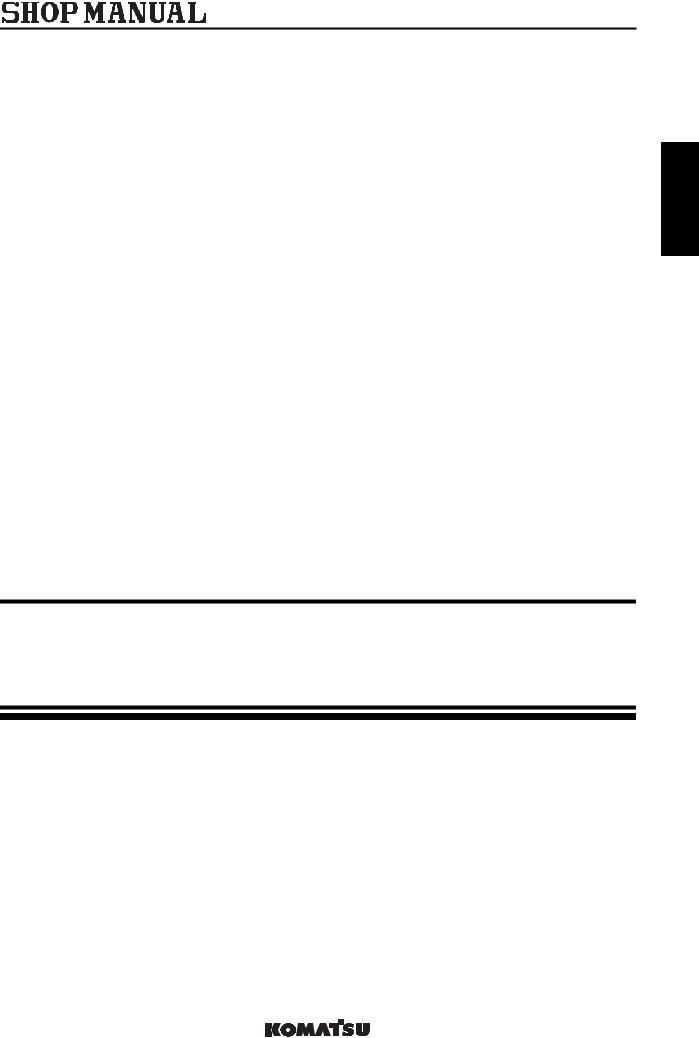
UEN00376-00
HYDRAULIC EXCAVATOR
PC800-8
PC800LC-8
Machine model |
Serial number |
PC800-8 |
50001 and up |
PC800LC-8 |
50001 and up |
00 Index and foreword |
|
Foreword and general information |
|
Foreword and general information .................................................................................................................. |
2 |
Safety notice ........................................................................................................................................ |
2 |
How to read the shop manual .............................................................................................................. |
6 |
Explanation of terms for maintenance standard................................................................................... |
8 |
Handling electric equipment and hydraulic component...................................................................... |
10 |
How to read electric wire code ........................................................................................................... |
18 |
Method of disassembling and connecting push-pull type coupler...................................................... |
21 |
Standard tightening torque table ........................................................................................................ |
24 |
Conversion table ................................................................................................................................ |
28 |
PC800, 800LC-8 |
1 |
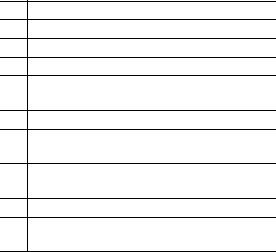
UEN00376-00 |
00 Index and foreword |
Foreword and general information |
(Rev. 2005/11) |
Safety notice
Important safety notice
Proper service and repair are extremely important for safe machine operation. The service and repair techniques recommended by Komatsu and described in this manual are both effective and safe. Some of these techniques require the use of tools specially designed by Komatsu for the specific purpose.
To prevent injury to workers, the symbol kis used to mark safety precautions in this manual. The cautions accompanying these symbols should always be followed carefully. If any dangerous situation arises or may possibly arise, first consider safety, and take the necessary actions to deal with the situation.
1. General precautions
k Mistakes in operation are extremely dangerous. Read the Operation and Maintenance Manual carefully before operating the machine.
1)Before carrying out any greasing or repairs, read all the safety plates stuck to the machine. For the locations of the safety plates and detailed explanation of precautions, see the Operation and Maintenance Manual.
2)Decide a place in the repair workshop to keep tools and removed parts. Always keep the tools and parts in their correct places. Always keep the work area clean and make sure that there is no dirt, water, or oil on the floor. Smoke only in the areas provided for smoking. Never smoke while working.
3)When carrying out any operation, always wear safety shoes and helmet. Do not wear loose work clothes, or clothes with buttons missing.
qAlways wear safety glasses when hitting parts with a hammer.
qAlways wear safety glasses when grinding parts with a grinder, etc.
4)When carrying out any operation with 2 or more workers, always agree on the operating procedure before starting. Always inform your fellow workers before starting any step of the operation. Before starting work, hang UNDER REPAIR signs in the operator's compartment.
5)Only qualified workers must carry out work and operation which require license or qualification.
6)Keep all tools in good condition, learn the correct way to use them, and use the proper ones of them. Before starting work, thoroughly check the tools, machine, forklift, service car, etc.
7)If welding repairs are needed, always have a trained and experienced welder carry out the work. When carrying out welding work, always wear welding gloves, apron, shielding goggles, cap and other clothes suited for welding work.
8)Before starting work, warm up your body thoroughly to start work under good condition.
Safety points
1Good arrangement
2Correct work clothes
3Following work standard
4Making and checking signs
5Prohibition of operation and handling by unlicensed workers
6Safety check before starting work
7Wearing protective goggles (for cleaning or grinding work)
8Wearing shielding goggles and protectors (for welding work)
9Good physical condition and preparation
10Precautions against work which you are not used to or you are used to too much
2.Preparations for work
1)Before adding oil or making any repairs, park the machine on hard and level ground, and apply the parking brake and block the wheels or tracks to prevent the machine from moving.
2)Before starting work, lower the work equipment (blade, ripper, bucket, etc.) to the ground. If this is not possible, insert the lock pin or use blocks to prevent the work equipment from falling. In addition, be sure to lock all the control levers and hang warning signs on them.
2 |
PC800, 800LC-8 |
00 Index and foreword |
UEN00376-00 |
3)When disassembling or assembling, support the machine with blocks, jacks, or stands before starting work.
4)Remove all mud and oil from the steps or other places used to get on and off the machine. Always use the handrails, ladders or steps when getting on or off the machine. Never jump on or off the machine. If it is impossible to use the handrails, ladders or steps, use a stand to provide safe footing.
3.Precautions during work
1)Before disconnecting or removing components of the oil, water, or air circuits, first release the pressure completely from the circuit. When removing the oil filler cap, a drain plug, or an oil pressure pickup plug, loosen it slowly to prevent the oil from spurting out.
2)The coolant and oil in the circuits are hot when the engine is stopped, so be careful not to get scalded. Wait for the oil and coolant to cool before carrying out any work on the oil or water circuits.
3)Before starting work, stop the engine. When working on or around a rotating part, in particular, stop the engine. When checking the machine without stopping the engine (measuring oil pressure, revolving speed, temperature, etc.), take extreme care not to get rolled or caught in rotating parts or moving parts.
4)Before starting work, remove the leads from the battery. Always remove the lead from the negative (–) terminal first.
5)When raising a heavy component (heavier than 25 kg), use a hoist or crane. Before starting work, check that the slings (wire ropes, chains, and hooks) are free from damage. Always use slings which have ample capacity and install them to proper places. Operate the hoist or crane slowly to prevent the component from hitting any other part. Do not work with any part still raised by the hoist or crane.
6)When removing a cover which is under internal pressure or under pressure from a spring, always leave 2 bolts in diagonal positions. Loosen those bolts gradually and alternately to release the pressure, and then remove the cover.
7)When removing components, be careful not to break or damage the electrical wiring. Damaged wiring may cause electrical fires.
8)When removing piping, stop the fuel or oil from spilling out. If any fuel or oil drips onto the floor, wipe it up immediately. Fuel or oil on the floor can cause you to slip and can even start fires.
9)As a general rule, do not use gasoline to wash parts. Do not use it to clean electrical parts, in particular.
10)Be sure to assemble all parts again in their original places. Replace any damaged parts and parts which must not be reused with new parts. When installing hoses and wires, be sure that they will not be damaged by contact with other parts when the machine is operated.
11)When installing high pressure hoses, make sure that they are not twisted. Damaged tubes are dangerous, so be extremely careful when installing tubes for high pressure circuits. In addition, check that connecting parts are correctly installed.
12)When assembling or installing parts, always tighten them to the specified torques. When installing protective parts such as guards, or parts which vibrate violently or rotate at high speed, be particularly careful to check that they are installed correctly.
13)When aligning 2 holes, never insert your fingers or hand. Be careful not to get your fingers caught in a hole.
14)When measuring hydraulic pressure, check that the measuring tools are correctly assembled.
15)Take care when removing or installing the tracks of track-type machines. When removing the track, the track separates suddenly, so never let anyone stand at either end of the track.
16)If the engine is operated for a long time in a place which is not ventilated well, you may suffer from gas poisoning. Accordingly, open the windows and doors to ventilate well.
PC800, 800LC-8 |
3 |
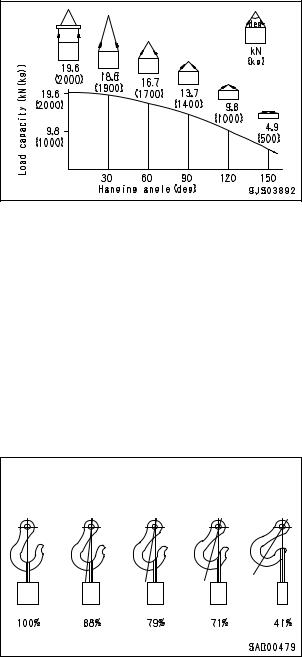
UEN00376-00 |
00 Index and foreword |
4.Precautions for sling work and making signs
1)Only one appointed worker must make signs and co-workers must communicate with each other frequently. The appointed sign maker must make specified signs clearly at a place where he is seen well from the operator's seat and where he can see the working condition easily. The sign maker must always stand in front of the load and guide the operator safely.
q Do not stand under the load. q Do not step on the load.
2)Check the slings before starting sling
work.
3)Keep putting on gloves during sling work. (Put on leather gloves, if available.)
4)Measure the weight of the load by the eye and check its center of gravity.
5)Use proper sling according to the weight of the load and method of slinging. If too thick wire ropes are used to sling a light load, the load may slip and fall.
6)Do not sling a load with 1 wire rope alone. If it is slung so, it may rotate and may slip out of the rope. Install 2 or more wire
ropes symmetrically.
k Slinging with one rope may cause
turning of the load during hoisting, untwisting of the rope, or slipping of the rope from its original winding position on the load, which can result in a dangerous accident.
7)Limit the hanging angle to 60°, as a rule. Do not sling a heavy load with ropes forming a wide hanging angle from the hook. When hoisting a load with 2 or more ropes, the force subjected to each rope will increase with the hanging angle. The table below shows the variation of allowable load in kN {kg} when hoisting is made with 2 ropes, each of which is allowed to sling up to 9.8 kN {1,000 kg} vertically, at various hanging angles. When the 2 ropes sling a load vertically, up to 19.6 kN {2,000 kg} of total weight can be suspended. This weight is reduced to 9.8 kN {1,000 kg} when the 2 ropes make a hanging angle of 120°. If the 2 ropes sling a 19.6 kN {2,000 kg} load at a lifting angle of 150°, each of them is subjected to a force as large as 39.2 kN {4,000 kg}.
8)When installing wire ropes to an angular load, apply pads to protect the wire ropes. If the load is slippery, apply proper material to prevent the wire rope from slipping.
9)Use the specified eyebolts and fix wire ropes, chains, etc. to them with shackles, etc.
10)Apply wire ropes to the middle portion of the hook.
qSlinging near the tip of the hook may cause the rope to slip off the hook during hoisting. The hook has the maximum strength at the middle portion.
11)Do not use twisted or kinked wire ropes.
12)When lifting up a load, observe the following.
qWind in the crane slowly until wire ropes are stretched. When settling the wire ropes with the hand, do not grasp them but press them from above. If you grasp them, your fingers may be caught.
qAfter the wire ropes are stretched, stop the crane and check the condition of the slung load, wire ropes, and pads.
4 |
PC800, 800LC-8 |
00 Index and foreword |
UEN00376-00 |
qIf the load is unstable or the wire rope or chains are twisted, lower the load and lift it up again.
qDo not lift up the load slantingly.
13)When lifting down a load, observe the following.
qWhen lifting down a load, stop it temporarily at 30 cm above the floor, and then lower it slowly.
qCheck that the load is stable, and then remove the sling.
qRemove kinks and dirt from the wire ropes and chains used for the sling work, and put them in the specified place.
5.Precautions for using mobile crane
a Read the Operation and Maintenance Manual of the crane carefully in advance and operate the crane safely.
6.Precautions for using overhead hoist crane k When raising a heavy part (heavier than 25 kg), use a hoist, etc. In Disassembly and assembly, the weight of a
part heavier than 25 kg is indicated after the mark of 4.
1)Before starting work, inspect the wire ropes, brake, clutch, controller, rails, over wind stop device, electric shock prevention earth leakage breaker, crane collision prevention device, and power application warning lamp, and check safety.
2)Observe the signs for sling work.
3)Operate the hoist at a safe place.
4)Check the direction indicator plates (east, west, south, and north) and the directions of the control buttons without fail.
5)Do not sling a load slantingly. Do not move the crane while the slung load is swinging.
6)Do not raise or lower a load while the crane is moving longitudinally or laterally.
7)Do not drag a sling.
8)When lifting up a load, stop it just after it leaves the ground and check safety, and then lift it up.
9)Consider the travel route in advance and lift up a load to a safe height.
10)Place the control switch on a position where it will not be an obstacle to work and passage.
11)After operating the hoist, do not swing the control switch.
12)Remember the position of the main switch so that you can turn off the power immediately in an emergency.
13)If the hoist stops because of a power failure, turn the power switch OFF. When turning on a switch which was turned OFF by the electric shock prevention earth leakage breaker, check that the devices related to that switch are not in operation state.
14)If you find an obstacle around the hoist, stop the operation.
15)After finishing the work, stop the hoist at the specified position and raise the hook to at least 2 m above the floor. Do not leave the sling installed to the hook.
7.Selecting wire ropes
1)Select adequate ropes depending on the weight of parts to be hoisted, referring to the table below.
Wire ropes
(Standard “Z” twist ropes without galvanizing) (JIS G3525, No. 6, Type 6X37-A)
Nominal |
Allowable load |
|
|
diameter of rope |
|
||
|
|
|
|
|
|
|
|
mm |
kN |
|
ton |
10 |
8.8 |
|
0.9 |
12 |
12.7 |
|
1.3 |
14 |
17.3 |
|
1.7 |
16 |
22.6 |
|
2.3 |
18 |
28.6 |
|
2.9 |
20 |
35.3 |
|
3.6 |
25 |
55.3 |
|
5.6 |
30 |
79.6 |
|
8.1 |
40 |
141.6 |
|
14.4 |
50 |
221.6 |
|
22.6 |
60 |
318.3 |
|
32.4 |
aThe allowable load is one-sixth of the breaking strength of the rope used (Safety coefficient: 6).
PC800, 800LC-8 |
5 |

UEN00376-00 |
00 Index and foreword |
How to read the shop manual
q Some attachments and optional parts in this shop manual may not be delivered to certain areas. If one of them is required, consult KOMATSU distributors.
q Materials and specifications are subject to change without notice.
qShop manuals are divided into the “Chassis volume” and “Engine volume”. For the engine unit, see the engine volume of the engine model mounted on the machine.
1.Composition of shop manual
This shop manual contains the necessary technical information for services performed in a workshop. For ease of understanding, the manual is divided into the following sections.
00.Index and foreword
This section explains the shop manuals list, table of contents, safety, and basic information.
01.Specification
This section explains the specifications of the machine.
10.Structure, function and maintenance standard
This section explains the structure, function, and maintenance standard values of each component. The structure and function sub-section explains the structure and function of each component. It serves not only to give an understanding of the structure, but also serves as reference material for troubleshooting. The maintenance standard sub-section explains the criteria and remedies for disassembly and service.
20.Standard value table
This section explains the standard values for new machine and judgement criteria for testing, adjusting, and troubleshooting. This standard value table is used to check the standard values in testing and adjusting and to judge parts in troubleshooting.
30.Testing and adjusting
This section explains measuring instruments and measuring methods for testing and adjusting, and method of adjusting each part. The standard values and judgement criteria for testing and adjusting are explained in Testing and adjusting.
40.Troubleshooting
This section explains how to find out failed parts and how to repair them. The troubleshooting is divided by failure modes. The “S mode” of the troubleshooting related to the engine may be also explained in the Chassis volume and Engine volume. In this case, see the Chassis volume.
50.Disassembly and assembly
This section explains the special tools and procedures for removing, installing, disassembling, and assembling each component, as well as precautions for them. In addition, tightening torque and quantity and weight of coating material, oil, grease, and coolant necessary for the work are also explained.
90.Diagrams and drawings (chassis volume)/Repair and replacement of parts (engine volume) q Chassis volume
This section gives hydraulic circuit diagrams and electrical circuit diagrams.
qEngine volume
This section explains the method of reproducing, repairing, and replacing parts.
2.Revision and distribution
Any additions, revisions, or other change of notices will be sent to KOMATSU distributors. Get the most up-to-date information before you start any work.
6 |
PC800, 800LC-8 |
00 Index and foreword |
UEN00376-00 |
3.Filing method
File by the brochures in the correct order of the form number printed in the shop manual composition table.
qRevised edition mark
When a manual is revised, the ones and tens digits of the form number of each brochure is increased by 1. (Example: 00, 01, 02 …)
qRevisions
Revised brochures are shown in the shop manual composition table.
4.Symbols
Important safety and quality portions are marked with the following symbols so that the shop manual will be used practically.
Symbol |
Item |
Remarks |
|
k |
Safety |
Special safety precautions are necessary when performing work. |
|
a |
Caution |
Special technical precautions or other precautions for preserving stan- |
|
dards are necessary when performing work. |
|||
|
|
||
|
|
|
|
4 |
Weight |
Weight of parts of component or parts. Caution necessary when |
|
selecting hoisting wire, or when working posture is important, etc. |
|||
3 |
Tightening |
Places that require special attention for tightening torque during |
|
|
torque |
assembly. |
|
2 |
Coat |
Places to be coated with adhesives, etc. during assembly. |
|
5 |
Oil, coolant |
Places where oil, etc. must be added, and capacity. |
|
6 |
Drain |
Places where oil, etc. must be drained, and quantity to be drained. |
5.Units
In this shop manual, the units are indicated with International System of units (SI). For reference, conventionally used Gravitational System of units is indicated in parentheses { }.
PC800, 800LC-8 |
7 |
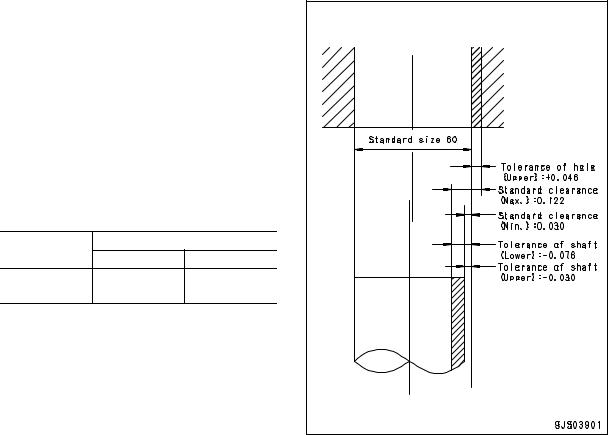
UEN00376-00 |
00 Index and foreword |
Explanation of terms for maintenance standard
The maintenance standard values necessary for judgment of products and parts are described by the following terms.
1.Standard size and tolerance
q To be accurate, the finishing size of parts is a little different from one to another.
qTo specify a finishing size of a part, a temporary standard size is set and an allowable difference from that size is indicated.
qThe above size set temporarily is called the “standard size” and the range of difference from the standard size is called the “tolerance”.
qThe tolerance with the symbols of + or – is indicated on the right side of the standard size.
Example: |
|
|
Standard size |
Tolerance |
|
120 |
–0.022 |
|
–0.126 |
||
|
||
|
|
a |
The tolerance may be indicated in the text |
|||
|
and a table as [standard size (upper limit |
|||
|
of tolerance/lower limit of tolerance)]. |
|||
|
Example) 120 (–0.022/–0.126) |
|
||
q |
Usually, the size of a hole and the size of |
|||
|
the shaft to be fitted to that hole are indi- |
|||
|
cated by the same standard size and dif- |
|||
|
ferent tolerances of the hole and shaft. |
|||
|
The tightness of fit is decided by the toler- |
|||
|
ance. |
|
|
|
q |
Indication of size of rotating shaft and hole |
|||
|
and relationship drawing of them |
|||
Example: |
|
|
||
Standard size |
Tolerance |
|||
Shaft |
Hole |
|||
|
|
|||
|
60 |
–0.030 |
+0.046 |
|
|
–0.076 |
0 |
||
|
|
|||
8 |
|
|
PC800, 800LC-8 |
|
00 Index and foreword |
UEN00376-00 |
2.Standard clearance and standard value
q The clearance made when new parts are assembled is called the “standard clearance“, which is indicated by the range from the minimum clearance to the maximum clearance.
qWhen some parts are repaired, the clearance is generally adjusted to the standard clearance.
qA value of performance and function of new products or equivalent is called the “standard value“, which is indicated by a range or a target value.
qWhen some parts are repaired, the value of performance/function is set to the standard value.
3.Standard interference
qWhen the size of a hole is smaller than the size of a shaft because of the standard size and tolerance, the difference between these sizes is called the “interference”.
qThe range (A – B) from the difference (A) between the minimum size of the shaft and the maximum size of the hole to the difference (B) between the maximum size of the shaft and the minimum size of the hole is the “standard interference”.
qAfter repairing or replacing some parts, measure the size of their hole and shaft and check that the interference is in the standard range.
4.Repair limit and allowable value
qThe size of a part changes because of wear and deformation while it is used. The limit of changed size is called the “repair limit”.
qIf a part is worn to the repair limit must be replaced or repaired.
qThe performance and function of a product lowers while it is used. A value below which the product can be used without causing a problem is called the “allowable value”.
qIf a product is worn to the allowable value, it must be checked or repaired. Since the permissible value is estimated from various tests or experiences in most cases, however, it must be judged after considering the operating condition and customer's requirement.
5.Clearance limit
q Parts can be used until the clearance between them is increased to a certain limit. The limit at which those parts cannot be used is called the “clearance limit”.
qIf the clearance between the parts exceeds the clearance limit, they must be replaced or repaired.
6.Interference limit
qThe allowable maximum interference between the hole of a part and the shaft of another part to be assembled is called the “interference limit”.
qThe interference limit shows the repair limit of the part of smaller tolerance.
qIf the interference between the parts exceeds the interference limit, they must be replaced or repaired.
PC800, 800LC-8 |
9 |
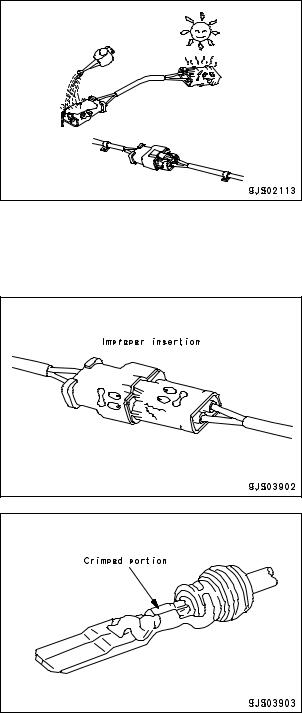
UEN00376-00 |
00 Index and foreword |
Handling electric equipment and hydraulic component
To maintain the performance of the machine over a long period, and to prevent failures or other troubles before they occur, correct “operation“, “maintenance and inspection“, “troubleshooting“, and “repairs” must be carried out. This section deals particularly with correct repair procedures for mechatronics and is aimed at improving the quality of repairs. For this purpose, it gives sections on “Handling electric equipment” and “Handling hydraulic equipment” (particularly gear oil and hydraulic oil).
Points to remember when handling electric equipment
1.Handling wiring harnesses and connectors
Wiring harnesses consist of wiring connecting one component to another component, connectors used for connecting and disconnecting
one wire from another wire, and protectors or tubes used for protecting the wiring. Compared with other electrical components fitted in boxes or cases, wiring harnesses are more likely to be affected by the direct effects of rain, water, heat, or vibration. Furthermore, during inspection and repair operations, they are frequently removed and installed again, so they are likely to suffer deformation or damage. For this reason, it is necessary to be extremely careful when handling wiring harnesses.
2.Main failures occurring in wiring harness
1)Defective contact of connectors (defective contact between male and female)
Problems with defective contact are likely to occur because the male connector is not properly inserted into the female connector, or because one or both of the connectors is deformed or the position is not correctly aligned, or because there is corrosion or oxidization of the contact surfaces.
2)Defective crimping or soldering of connectors
The pins of the male and female connectors are in contact at the crimped terminal or soldered portion, but if there is excessive force brought to bear on the wiring, the plating at the joint will peel and cause improper connection or breakage.
10 |
PC800, 800LC-8 |
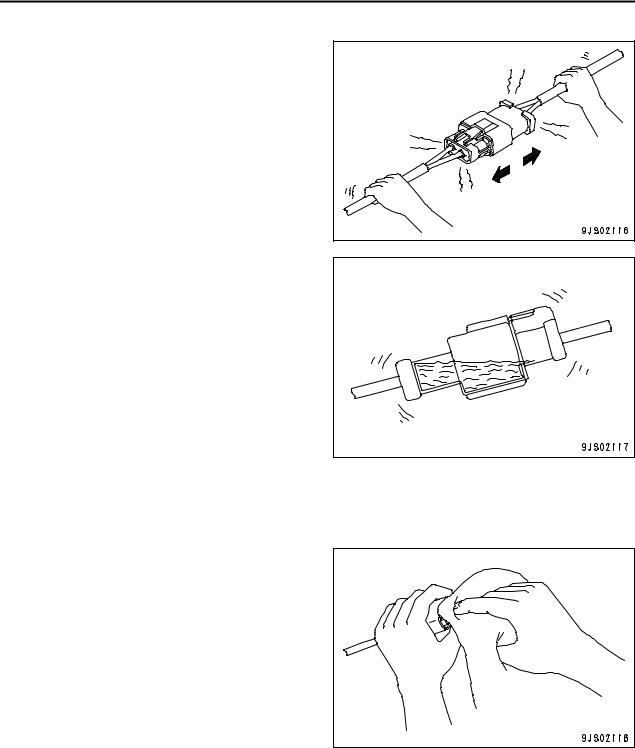
00 Index and foreword |
UEN00376-00 |
|
3) |
Disconnections in wiring |
|
|
If the wiring is held and the connectors are |
|
|
pulled apart, or components are lifted with |
|
|
a crane with the wiring still connected, or a |
|
|
heavy object hits the wiring, the crimping |
|
|
of the connector may separate, or the sol- |
|
|
dering may be damaged, or the wiring |
|
|
may be broken. |
|
4) High-pressure water entering connector |
|
|
|
The connector is designed to make it diffi- |
|
|
cult for water to enter (drip-proof struc- |
|
|
ture), but if high-pressure water is sprayed |
|
|
directly on the connector, water may enter |
|
|
the connector, depending on the direction |
|
|
of the water jet. Accordingly, take care not |
|
|
splash water over the connector. The con- |
|
|
nector is designed to prevent water from |
|
|
entering, but at the same time, if water |
|
|
does enter, it is difficult for it to be drained. |
|
|
Therefore, if water should get into the con- |
|
|
nector, the pins will be short-circuited by |
|
|
the water, so if any water gets in, immedi- |
|
|
ately dry the connector or take other |
|
|
appropriate action before passing electric- |
|
|
ity through it. |
|
5) Oil or dirt stuck to connector |
|
|
|
If oil or grease are stuck to the connector |
|
|
and an oil film is formed on the mating sur- |
|
|
face between the male and female pins, |
|
|
the oil will not let the electricity pass, so |
|
|
there will be defective contact. If there is |
|
|
oil or grease stuck to the connector, wipe it |
|
|
off with a dry cloth or blow it dry with com- |
|
|
pressed air and spray it with a contact |
|
|
restorer. |
|
|
a When wiping the mating portion of the |
|
|
connector, be careful not to use |
|
|
excessive force or deform the pins. |
|
|
a If there is oil or water in the com- |
|
|
pressed air, the contacts will become |
|
|
even dirtier, so remove the oil and |
|
|
water from the compressed air com- |
|
|
pletely before cleaning with com- |
|
|
pressed air. |
|
PC800, 800LC-8 |
11 |
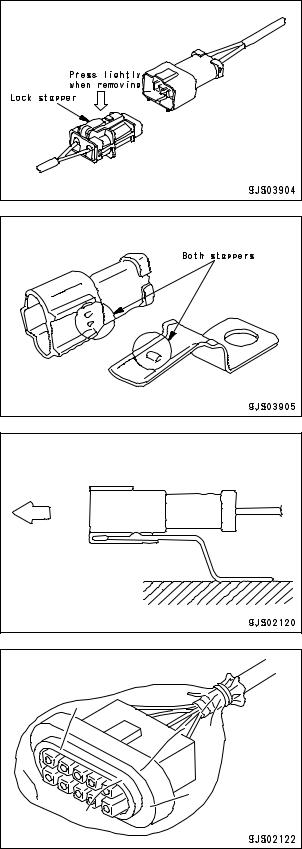
UEN00376-00 |
00 Index and foreword |
3.Removing, installing, and drying connectors and wiring harnesses
1)Disconnecting connectors
1] Hold the connectors when discon-
necting.
When disconnecting the connectors, hold the connectors. For connectors held by a screw, loosen the screw fully, then hold the male and female connectors in each hand and pull apart. For connectors which have a lock stopper, press down the stopper with your thumb and pull the connectors apart.
a Never pull with one hand.
2] When removing from clips
qBoth of the connector and clip have stoppers, which are engaged with each other when the connector is
installed.
qWhen removing a connector from a clip, pull the connector in a parallel direction to the clip for removing stop-
pers.
a If the connector is twisted up and down or to the left or right, the housing may break.
3] Action to take after removing connectors
After removing any connector, cover it with a vinyl bag to prevent any dust, dirt, oil, or water from getting in the connector portion.
aIf the machine is left disassembled for a long time, it is particularly easy for improper contact to occur, so always cover the connector.
12 |
PC800, 800LC-8 |
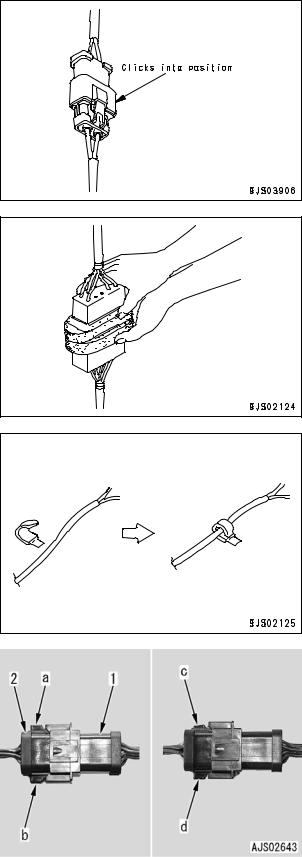
00 Index and foreword |
UEN00376-00 |
2)Connecting connectors
1] Check the connector visually.
Check that there is no oil, dirt, or water stuck to the connector pins (mating portion).
Check that there is no deformation, defective contact, corrosion, or dam-
age to the connector pins.
Check that there is no damage or breakage to the outside of the connector.
a If there is any oil, water, or dirt stuck to the connector, wipe it off with a dry cloth. If any water has got inside the connector, warm the inside of the wiring with a dryer, but be careful not to make it too hot as this will cause short circuits.
a If there is any damage or breakage, replace the connector.
2] Fix the connector securely.
Align the position of the connector correctly, and then insert it securely. For connectors with lock stopper, push in the connector until the stopper clicks into position.
3] Correct any protrusion of the boot and any misalignment of the wiring harness.
For connectors fitted with boots, correct any protrusion of the boot. In addition, if the wiring harness is misaligned, or the clamp is out of position, adjust it to its correct position.
aIf the connector cannot be corrected easily, remove the clamp and adjust the position.
q If the connector clamp has been removed, be sure to return it to its original position. Check also that there are no loose clamps.
3)Connecting DT connectors
Since the DT 8-pin and 12-pin heavy duty wire connectors have 2 latches respectively, push them in until they click 2 times.
1.Male connector
2.Female connector
qNormal locking state (Horizontal): a, b, d
q Incomplete locking state (Diagonal): c
PC800, 800LC-8 |
13 |
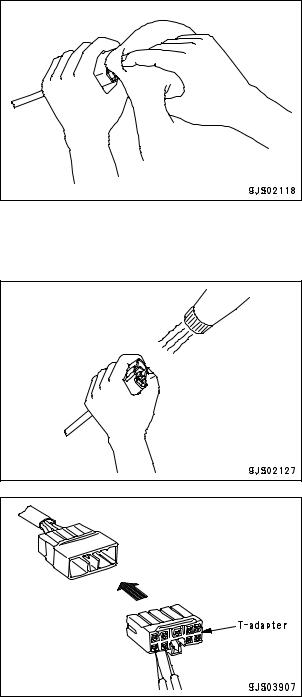
UEN00376-00 |
00 Index and foreword |
4)Drying wiring harness
If there is any oil or dirt on the wiring harness, wipe it off with a dry cloth. Avoid washing it in water or using steam. If the connector must be washed in water, do not use high-pressure water or steam directly on the wiring harness. If water
gets directly on the connector, do as follows.
1] Disconnect the connector and wipe off the water with a dry cloth.
a If the connector is blown dry with compressed air, there is the risk that oil in the air may cause defective contact, so remove all oil and water from the compressed air before blowing with air.
2] Dry the inside of the connector with a dryer.
If water gets inside the connector, use a dryer to dry the connector.
aHot air from the dryer can be used, but regulate the time that the hot air is used in order not to make the connector or related
parts too hot, as this will cause deformation or damage to the connector.
3] Carry out a continuity test on the connector.
After drying, leave the wiring harness disconnected and carry out a continuity test to check for any short circuits between pins caused by water.
aAfter completely drying the connector, blow it with contact restorer and reassemble.
14 |
PC800, 800LC-8 |
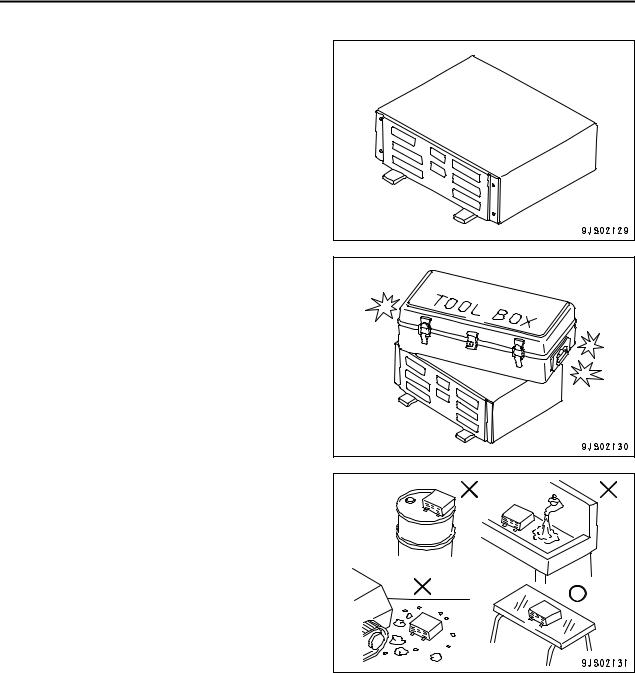
00 Index and foreword |
UEN00376-00 |
||
4. |
Handling controller |
|
|
|
1) |
The controller contains a microcomputer |
|
|
|
and electronic control circuits. These con- |
|
|
|
trol all of the electronic circuits on the |
|
|
|
machine, so be extremely careful when |
|
|
|
handling the controller. |
|
|
2) |
Do not place objects on top of the control- |
|
|
|
ler. |
|
|
3) |
Cover the control connectors with tape or |
|
|
|
a vinyl bag. Never touch the connector |
|
|
|
contacts with your hand. |
|
|
4) |
During rainy weather, do not leave the |
|
|
|
controller in a place where it is exposed to |
|
|
|
rain. |
|
|
5) |
Do not place the controller on oil, water, or |
|
|
|
soil, or in any hot place, even for a short |
|
|
|
time. (Place it on a suitable dry stand). |
|
|
6) |
Precautions when carrying out arc welding |
|
|
|
When carrying out arc welding on the |
|
|
|
body, disconnect all wiring harness con- |
|
|
|
nectors connected to the controller. Fit an |
|
|
|
arc welding ground close to the welding |
|
|
|
point. |
|
5. Points to remember when troubleshooting |
|||
|
electric circuits |
|
|
|
1) |
Always turn the power OFF before discon- |
|
|
|
necting or connecting connectors. |
|
|
2) |
Before carrying out troubleshooting, check |
|
|
|
that all the related connectors are properly |
|
|
|
inserted. |
|
|
|
a Disconnect and connect the related |
|
|
|
connectors several times to check. |
|
|
3) |
Always connect any disconnected con- |
|
|
|
nectors before going on to the next step. |
|
|
|
a If the power is turned ON with |
the |
|
|
connectors still disconnected, unnec- |
|
|
|
essary abnormality displays will be |
|
|
|
generated. |
|
|
4) |
When carrying out troubleshooting of cir- |
|
|
|
cuits (measuring the voltage, resistance, |
|
|
|
continuity, or current), move the related |
|
|
|
wiring and connectors several times and |
|
|
|
check that there is no change in the read- |
|
|
|
ing of the tester. |
|
|
|
a If there is any change, there is proba- |
|
|
|
bly defective contact in that circuit. |
|
PC800, 800LC-8 |
15 |
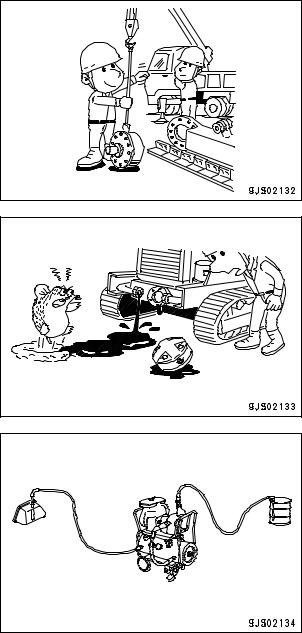
UEN00376-00 |
00 Index and foreword |
Points to remember when handling hydraulic equipment
With the increase in pressure and precision of hydraulic equipment, the most common cause of failure is dirt (foreign material) in the hydraulic circuit. When adding hydraulic oil, or when disassembling or assembling hydraulic equipment, it is necessary to be particularly careful.
1.Be careful of the operating environment.
Avoid adding hydraulic oil, replacing filters, or repairing the machine in rain or high winds, or places where there is a lot of dust.
2.Disassembly and maintenance work in the
field
If disassembly or maintenance work is carried out on hydraulic equipment in the field, there is danger of dust entering the equipment. It is also difficult to check the performance after repairs, so it is desirable to use unit exchange. Disassembly and maintenance of hydraulic equipment should be carried out in a specially prepared dustproof workshop, and the performance should be checked with special test equipment.
3.Sealing openings
After any piping or equipment is removed, the openings should be sealed with caps, tapes, or vinyl bags to prevent any dirt or dust from entering. If the opening is left open or is blocked with a rag, there is danger of dirt entering or of the surrounding area being made dirty by leaking oil so never do this. Do not simply drain oil out onto the ground, but collect it and ask the customer to dispose of it, or take it back with you for disposal.
4.Do not let any dirt or dust get in during refilling operations
Be careful not to let any dirt or dust get in when refilling with hydraulic oil. Always keep the oil filler and the area around it clean, and also use clean pumps and oil containers. If an oil cleaning device is used, it is possible to filter out the dirt that has collected during storage, so this is an even more effective method.
16 |
PC800, 800LC-8 |
